Comprehensive Report: Immunisation Impacts, Beliefs, Article Review
VerifiedAdded on 2024/05/17
|12
|3371
|448
Report
AI Summary
This report assesses the impacts of immunisation on pregnant women and their beliefs, addressing concerns and fears related to vaccination. It identifies reliable information sources, uses Boolean search strategies to find relevant articles, and evaluates the quality of research on immunisation. The report includes meta-analyses, systematic reviews, experimental quantitative studies, and qualitative studies to provide a comprehensive overview. It highlights the positive impacts of immunisation, such as protecting children and pregnant women from various diseases, and discusses how nurses and midwives can use this information to have informed discussions with parents. The report emphasizes the importance of evidence-based practices and dispels common misconceptions about immunisation, promoting informed decision-making in healthcare.

[ASSESSMENT - 1]
Paraphrase This Document
Need a fresh take? Get an instant paraphrase of this document with our AI Paraphraser
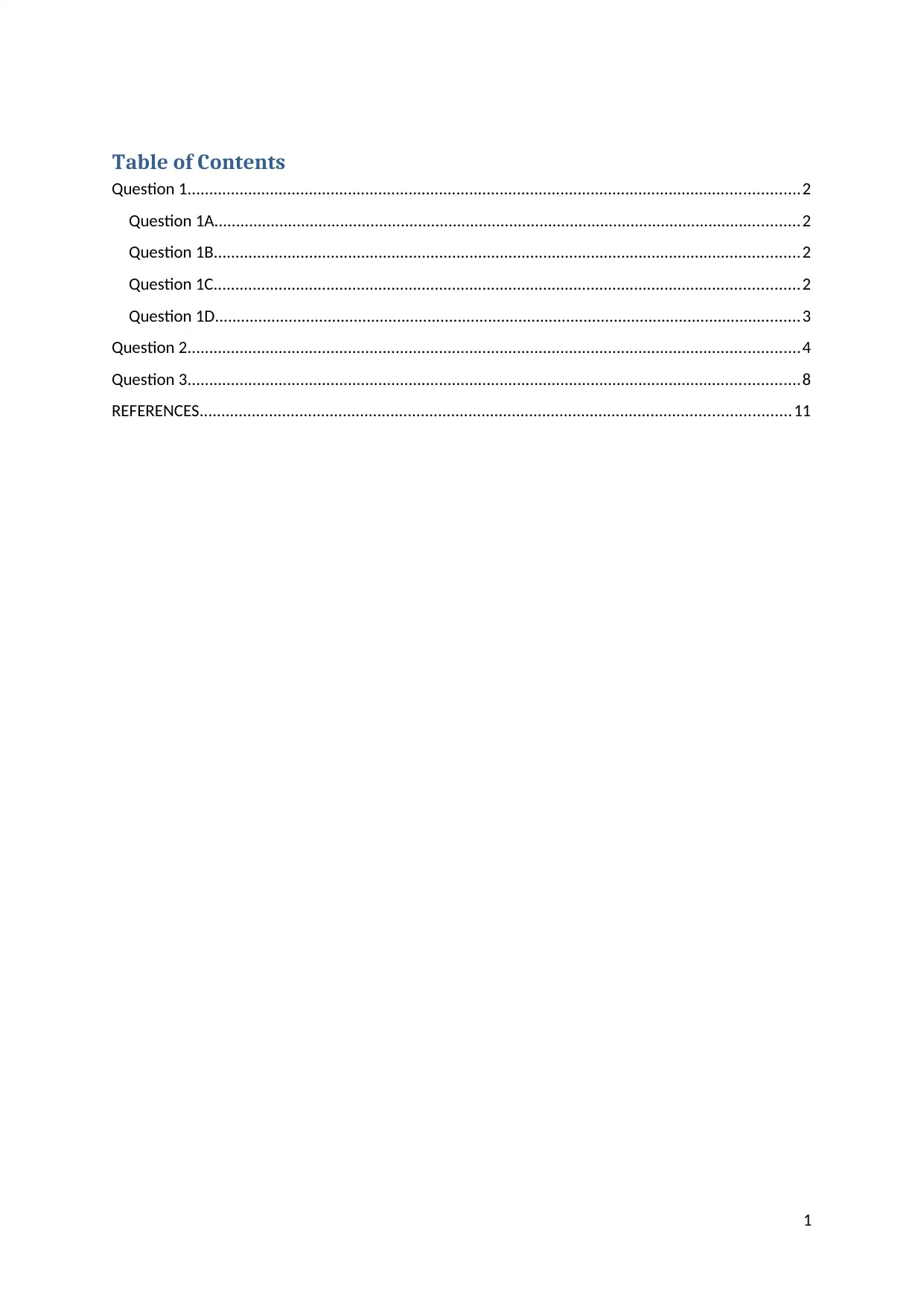
Table of Contents
Question 1.............................................................................................................................................2
Question 1A.......................................................................................................................................2
Question 1B.......................................................................................................................................2
Question 1C.......................................................................................................................................2
Question 1D.......................................................................................................................................3
Question 2.............................................................................................................................................4
Question 3.............................................................................................................................................8
REFERENCES........................................................................................................................................11
1
Question 1.............................................................................................................................................2
Question 1A.......................................................................................................................................2
Question 1B.......................................................................................................................................2
Question 1C.......................................................................................................................................2
Question 1D.......................................................................................................................................3
Question 2.............................................................................................................................................4
Question 3.............................................................................................................................................8
REFERENCES........................................................................................................................................11
1
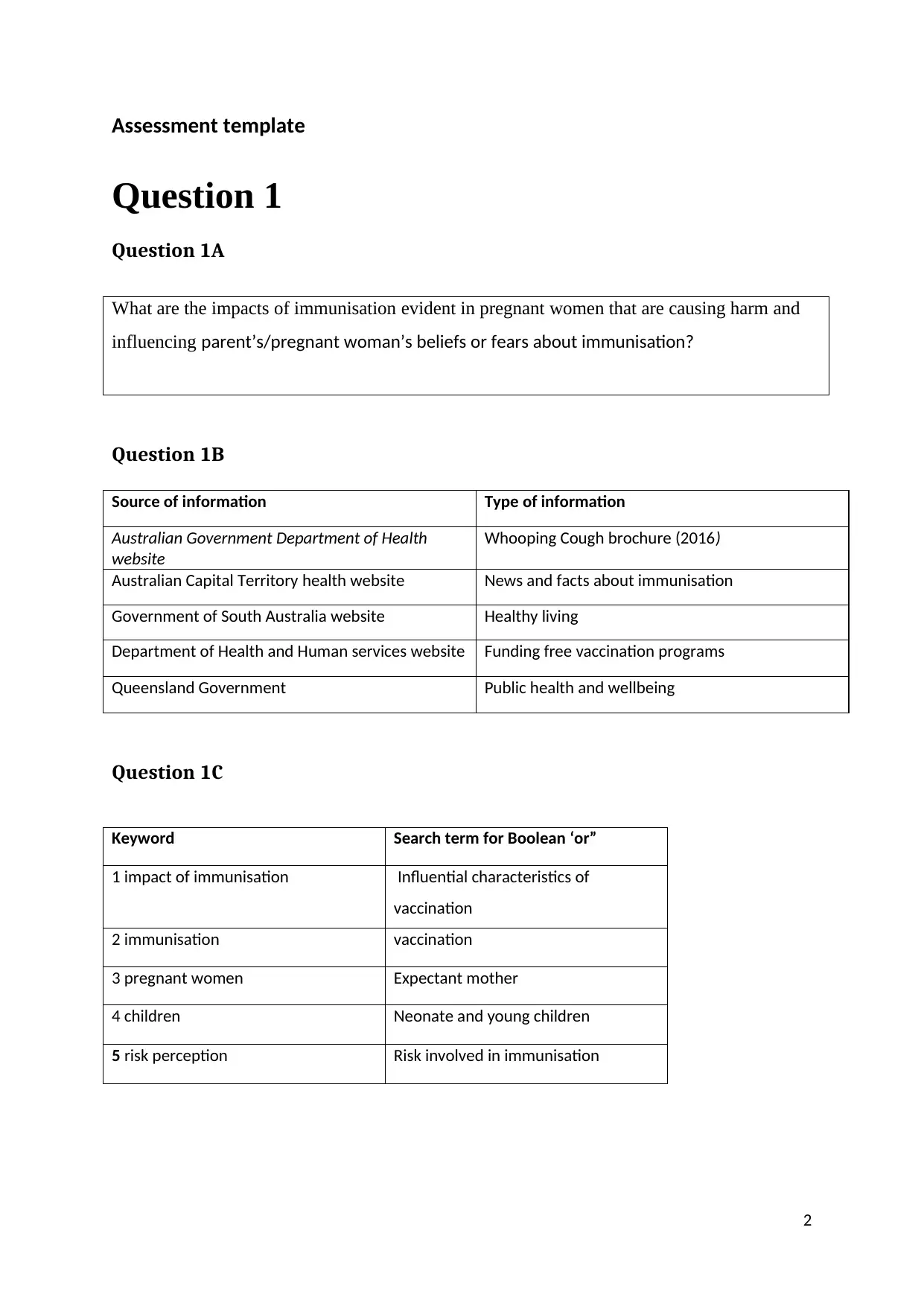
Assessment template
Question 1
Question 1A
What are the impacts of immunisation evident in pregnant women that are causing harm and
influencing parent’s/pregnant woman’s beliefs or fears about immunisation?
Question 1B
Source of information Type of information
Australian Government Department of Health
website
Whooping Cough brochure (2016)
Australian Capital Territory health website News and facts about immunisation
Government of South Australia website Healthy living
Department of Health and Human services website Funding free vaccination programs
Queensland Government Public health and wellbeing
Question 1C
Keyword Search term for Boolean ‘or”
1 impact of immunisation Influential characteristics of
vaccination
2 immunisation vaccination
3 pregnant women Expectant mother
4 children Neonate and young children
5 risk perception Risk involved in immunisation
2
Question 1
Question 1A
What are the impacts of immunisation evident in pregnant women that are causing harm and
influencing parent’s/pregnant woman’s beliefs or fears about immunisation?
Question 1B
Source of information Type of information
Australian Government Department of Health
website
Whooping Cough brochure (2016)
Australian Capital Territory health website News and facts about immunisation
Government of South Australia website Healthy living
Department of Health and Human services website Funding free vaccination programs
Queensland Government Public health and wellbeing
Question 1C
Keyword Search term for Boolean ‘or”
1 impact of immunisation Influential characteristics of
vaccination
2 immunisation vaccination
3 pregnant women Expectant mother
4 children Neonate and young children
5 risk perception Risk involved in immunisation
2
⊘ This is a preview!⊘
Do you want full access?
Subscribe today to unlock all pages.

Trusted by 1+ million students worldwide
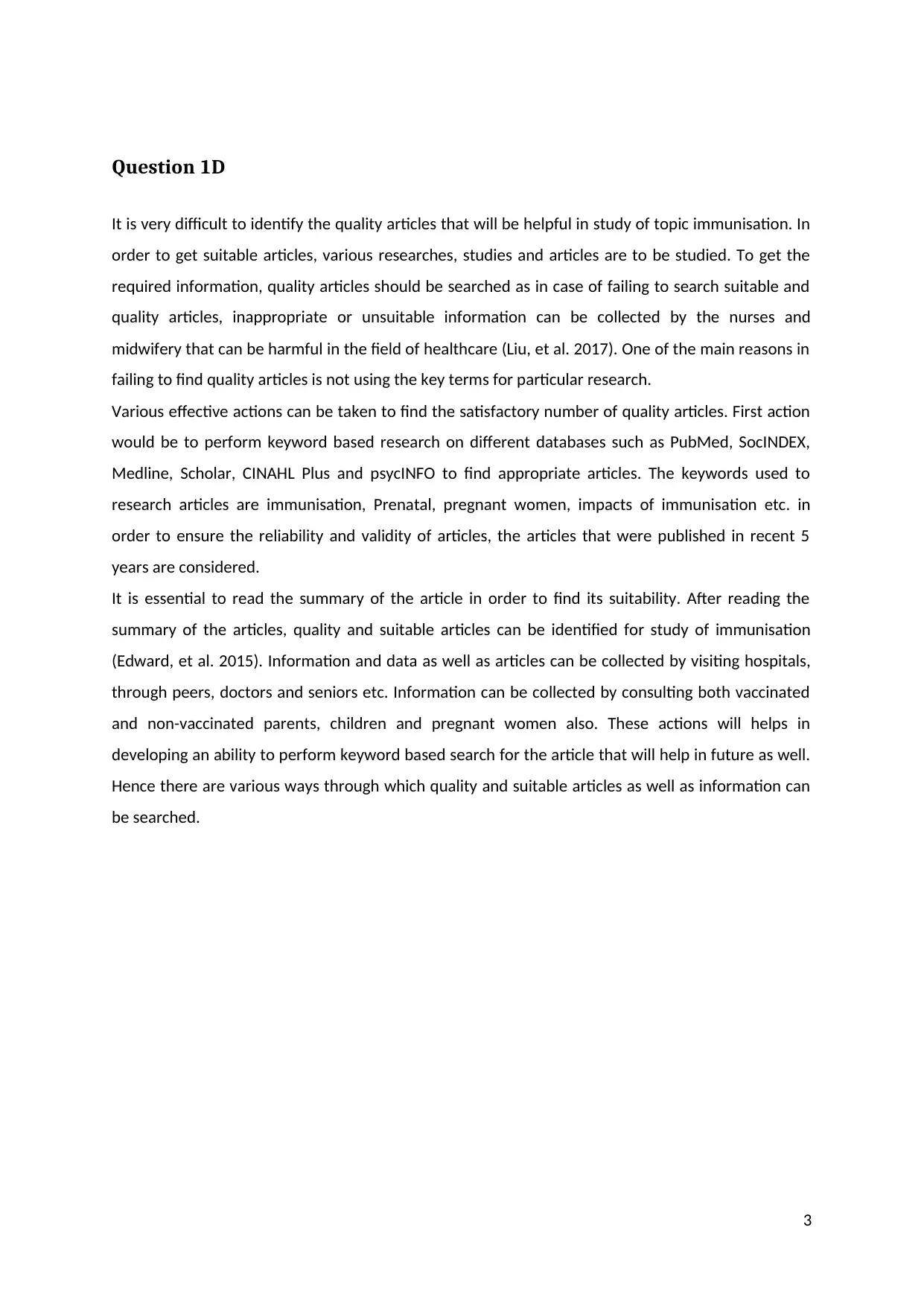
Question 1D
It is very difficult to identify the quality articles that will be helpful in study of topic immunisation. In
order to get suitable articles, various researches, studies and articles are to be studied. To get the
required information, quality articles should be searched as in case of failing to search suitable and
quality articles, inappropriate or unsuitable information can be collected by the nurses and
midwifery that can be harmful in the field of healthcare (Liu, et al. 2017). One of the main reasons in
failing to find quality articles is not using the key terms for particular research.
Various effective actions can be taken to find the satisfactory number of quality articles. First action
would be to perform keyword based research on different databases such as PubMed, SocINDEX,
Medline, Scholar, CINAHL Plus and psycINFO to find appropriate articles. The keywords used to
research articles are immunisation, Prenatal, pregnant women, impacts of immunisation etc. in
order to ensure the reliability and validity of articles, the articles that were published in recent 5
years are considered.
It is essential to read the summary of the article in order to find its suitability. After reading the
summary of the articles, quality and suitable articles can be identified for study of immunisation
(Edward, et al. 2015). Information and data as well as articles can be collected by visiting hospitals,
through peers, doctors and seniors etc. Information can be collected by consulting both vaccinated
and non-vaccinated parents, children and pregnant women also. These actions will helps in
developing an ability to perform keyword based search for the article that will help in future as well.
Hence there are various ways through which quality and suitable articles as well as information can
be searched.
3
It is very difficult to identify the quality articles that will be helpful in study of topic immunisation. In
order to get suitable articles, various researches, studies and articles are to be studied. To get the
required information, quality articles should be searched as in case of failing to search suitable and
quality articles, inappropriate or unsuitable information can be collected by the nurses and
midwifery that can be harmful in the field of healthcare (Liu, et al. 2017). One of the main reasons in
failing to find quality articles is not using the key terms for particular research.
Various effective actions can be taken to find the satisfactory number of quality articles. First action
would be to perform keyword based research on different databases such as PubMed, SocINDEX,
Medline, Scholar, CINAHL Plus and psycINFO to find appropriate articles. The keywords used to
research articles are immunisation, Prenatal, pregnant women, impacts of immunisation etc. in
order to ensure the reliability and validity of articles, the articles that were published in recent 5
years are considered.
It is essential to read the summary of the article in order to find its suitability. After reading the
summary of the articles, quality and suitable articles can be identified for study of immunisation
(Edward, et al. 2015). Information and data as well as articles can be collected by visiting hospitals,
through peers, doctors and seniors etc. Information can be collected by consulting both vaccinated
and non-vaccinated parents, children and pregnant women also. These actions will helps in
developing an ability to perform keyword based search for the article that will help in future as well.
Hence there are various ways through which quality and suitable articles as well as information can
be searched.
3
Paraphrase This Document
Need a fresh take? Get an instant paraphrase of this document with our AI Paraphraser
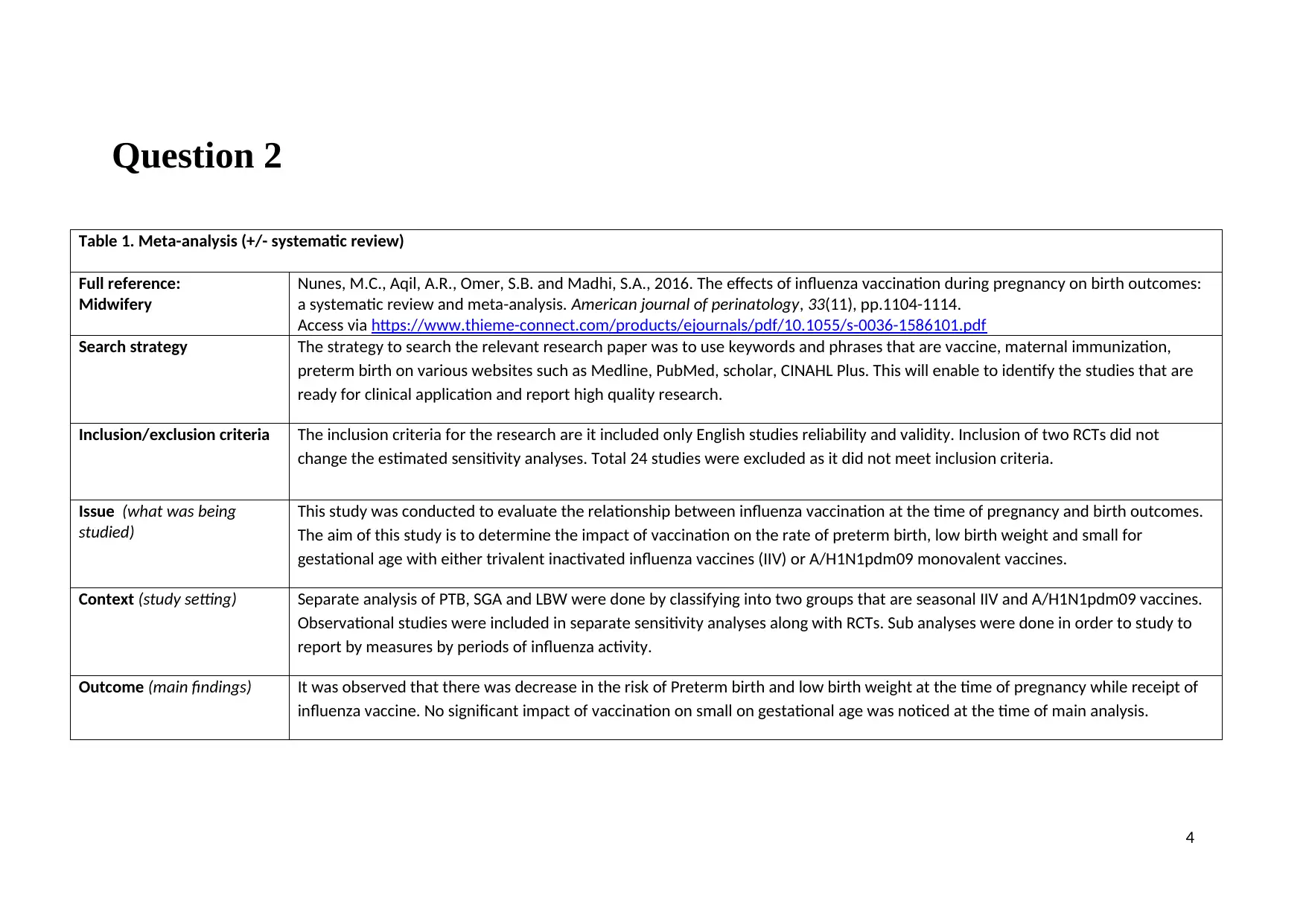
Question 2
Table 1. Meta-analysis (+/- systematic review)
Full reference:
Midwifery
Nunes, M.C., Aqil, A.R., Omer, S.B. and Madhi, S.A., 2016. The effects of influenza vaccination during pregnancy on birth outcomes:
a systematic review and meta-analysis. American journal of perinatology, 33(11), pp.1104-1114.
Access via https://www.thieme-connect.com/products/ejournals/pdf/10.1055/s-0036-1586101.pdf
Search strategy The strategy to search the relevant research paper was to use keywords and phrases that are vaccine, maternal immunization,
preterm birth on various websites such as Medline, PubMed, scholar, CINAHL Plus. This will enable to identify the studies that are
ready for clinical application and report high quality research.
Inclusion/exclusion criteria The inclusion criteria for the research are it included only English studies reliability and validity. Inclusion of two RCTs did not
change the estimated sensitivity analyses. Total 24 studies were excluded as it did not meet inclusion criteria.
Issue (what was being
studied)
This study was conducted to evaluate the relationship between influenza vaccination at the time of pregnancy and birth outcomes.
The aim of this study is to determine the impact of vaccination on the rate of preterm birth, low birth weight and small for
gestational age with either trivalent inactivated influenza vaccines (IIV) or A/H1N1pdm09 monovalent vaccines.
Context (study setting) Separate analysis of PTB, SGA and LBW were done by classifying into two groups that are seasonal IIV and A/H1N1pdm09 vaccines.
Observational studies were included in separate sensitivity analyses along with RCTs. Sub analyses were done in order to study to
report by measures by periods of influenza activity.
Outcome (main findings) It was observed that there was decrease in the risk of Preterm birth and low birth weight at the time of pregnancy while receipt of
influenza vaccine. No significant impact of vaccination on small on gestational age was noticed at the time of main analysis.
4
Table 1. Meta-analysis (+/- systematic review)
Full reference:
Midwifery
Nunes, M.C., Aqil, A.R., Omer, S.B. and Madhi, S.A., 2016. The effects of influenza vaccination during pregnancy on birth outcomes:
a systematic review and meta-analysis. American journal of perinatology, 33(11), pp.1104-1114.
Access via https://www.thieme-connect.com/products/ejournals/pdf/10.1055/s-0036-1586101.pdf
Search strategy The strategy to search the relevant research paper was to use keywords and phrases that are vaccine, maternal immunization,
preterm birth on various websites such as Medline, PubMed, scholar, CINAHL Plus. This will enable to identify the studies that are
ready for clinical application and report high quality research.
Inclusion/exclusion criteria The inclusion criteria for the research are it included only English studies reliability and validity. Inclusion of two RCTs did not
change the estimated sensitivity analyses. Total 24 studies were excluded as it did not meet inclusion criteria.
Issue (what was being
studied)
This study was conducted to evaluate the relationship between influenza vaccination at the time of pregnancy and birth outcomes.
The aim of this study is to determine the impact of vaccination on the rate of preterm birth, low birth weight and small for
gestational age with either trivalent inactivated influenza vaccines (IIV) or A/H1N1pdm09 monovalent vaccines.
Context (study setting) Separate analysis of PTB, SGA and LBW were done by classifying into two groups that are seasonal IIV and A/H1N1pdm09 vaccines.
Observational studies were included in separate sensitivity analyses along with RCTs. Sub analyses were done in order to study to
report by measures by periods of influenza activity.
Outcome (main findings) It was observed that there was decrease in the risk of Preterm birth and low birth weight at the time of pregnancy while receipt of
influenza vaccine. No significant impact of vaccination on small on gestational age was noticed at the time of main analysis.
4
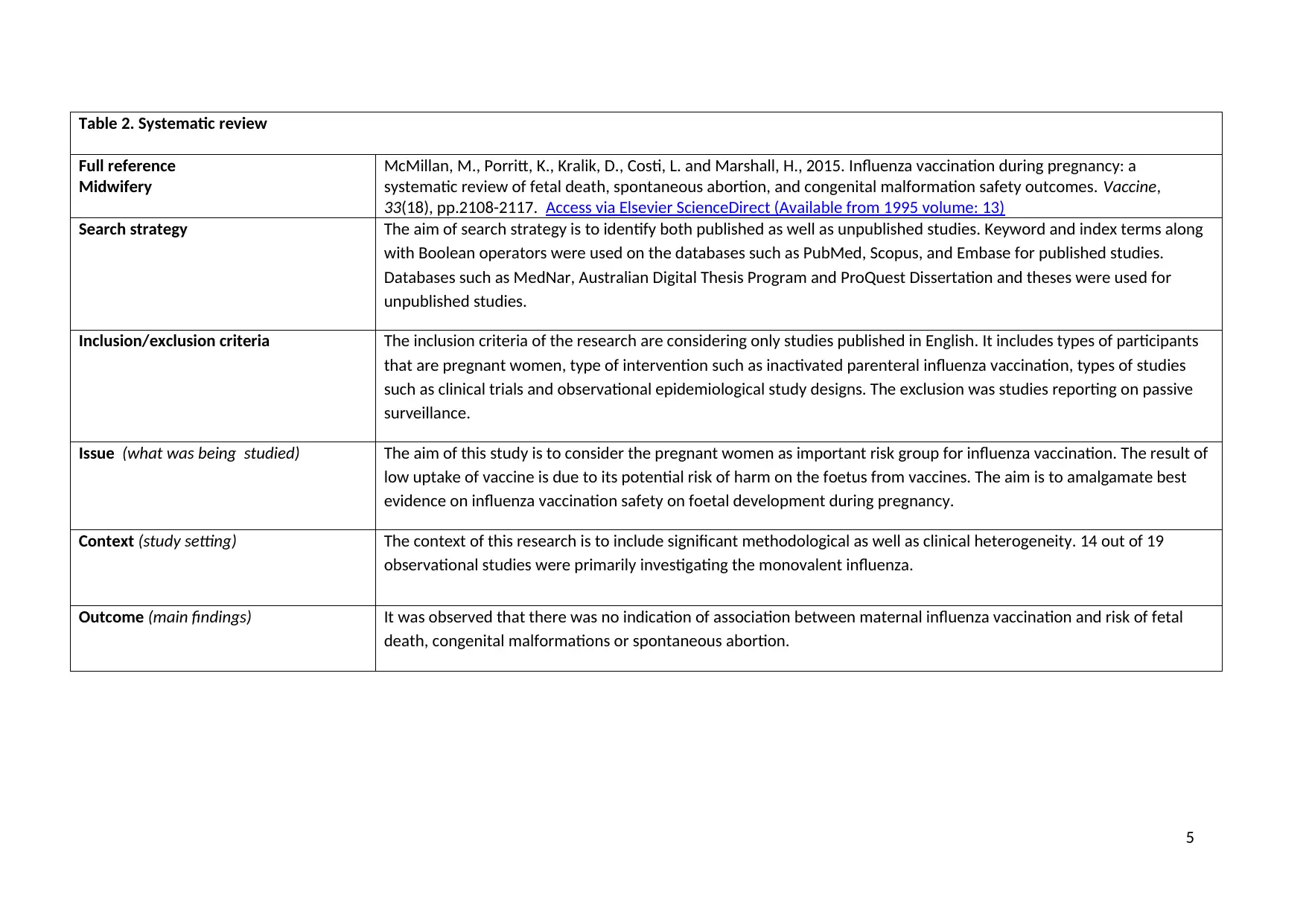
Table 2. Systematic review
Full reference
Midwifery
McMillan, M., Porritt, K., Kralik, D., Costi, L. and Marshall, H., 2015. Influenza vaccination during pregnancy: a
systematic review of fetal death, spontaneous abortion, and congenital malformation safety outcomes. Vaccine,
33(18), pp.2108-2117. Access via Elsevier ScienceDirect (Available from 1995 volume: 13)
Search strategy The aim of search strategy is to identify both published as well as unpublished studies. Keyword and index terms along
with Boolean operators were used on the databases such as PubMed, Scopus, and Embase for published studies.
Databases such as MedNar, Australian Digital Thesis Program and ProQuest Dissertation and theses were used for
unpublished studies.
Inclusion/exclusion criteria The inclusion criteria of the research are considering only studies published in English. It includes types of participants
that are pregnant women, type of intervention such as inactivated parenteral influenza vaccination, types of studies
such as clinical trials and observational epidemiological study designs. The exclusion was studies reporting on passive
surveillance.
Issue (what was being studied) The aim of this study is to consider the pregnant women as important risk group for influenza vaccination. The result of
low uptake of vaccine is due to its potential risk of harm on the foetus from vaccines. The aim is to amalgamate best
evidence on influenza vaccination safety on foetal development during pregnancy.
Context (study setting) The context of this research is to include significant methodological as well as clinical heterogeneity. 14 out of 19
observational studies were primarily investigating the monovalent influenza.
Outcome (main findings) It was observed that there was no indication of association between maternal influenza vaccination and risk of fetal
death, congenital malformations or spontaneous abortion.
5
Full reference
Midwifery
McMillan, M., Porritt, K., Kralik, D., Costi, L. and Marshall, H., 2015. Influenza vaccination during pregnancy: a
systematic review of fetal death, spontaneous abortion, and congenital malformation safety outcomes. Vaccine,
33(18), pp.2108-2117. Access via Elsevier ScienceDirect (Available from 1995 volume: 13)
Search strategy The aim of search strategy is to identify both published as well as unpublished studies. Keyword and index terms along
with Boolean operators were used on the databases such as PubMed, Scopus, and Embase for published studies.
Databases such as MedNar, Australian Digital Thesis Program and ProQuest Dissertation and theses were used for
unpublished studies.
Inclusion/exclusion criteria The inclusion criteria of the research are considering only studies published in English. It includes types of participants
that are pregnant women, type of intervention such as inactivated parenteral influenza vaccination, types of studies
such as clinical trials and observational epidemiological study designs. The exclusion was studies reporting on passive
surveillance.
Issue (what was being studied) The aim of this study is to consider the pregnant women as important risk group for influenza vaccination. The result of
low uptake of vaccine is due to its potential risk of harm on the foetus from vaccines. The aim is to amalgamate best
evidence on influenza vaccination safety on foetal development during pregnancy.
Context (study setting) The context of this research is to include significant methodological as well as clinical heterogeneity. 14 out of 19
observational studies were primarily investigating the monovalent influenza.
Outcome (main findings) It was observed that there was no indication of association between maternal influenza vaccination and risk of fetal
death, congenital malformations or spontaneous abortion.
5
⊘ This is a preview!⊘
Do you want full access?
Subscribe today to unlock all pages.

Trusted by 1+ million students worldwide
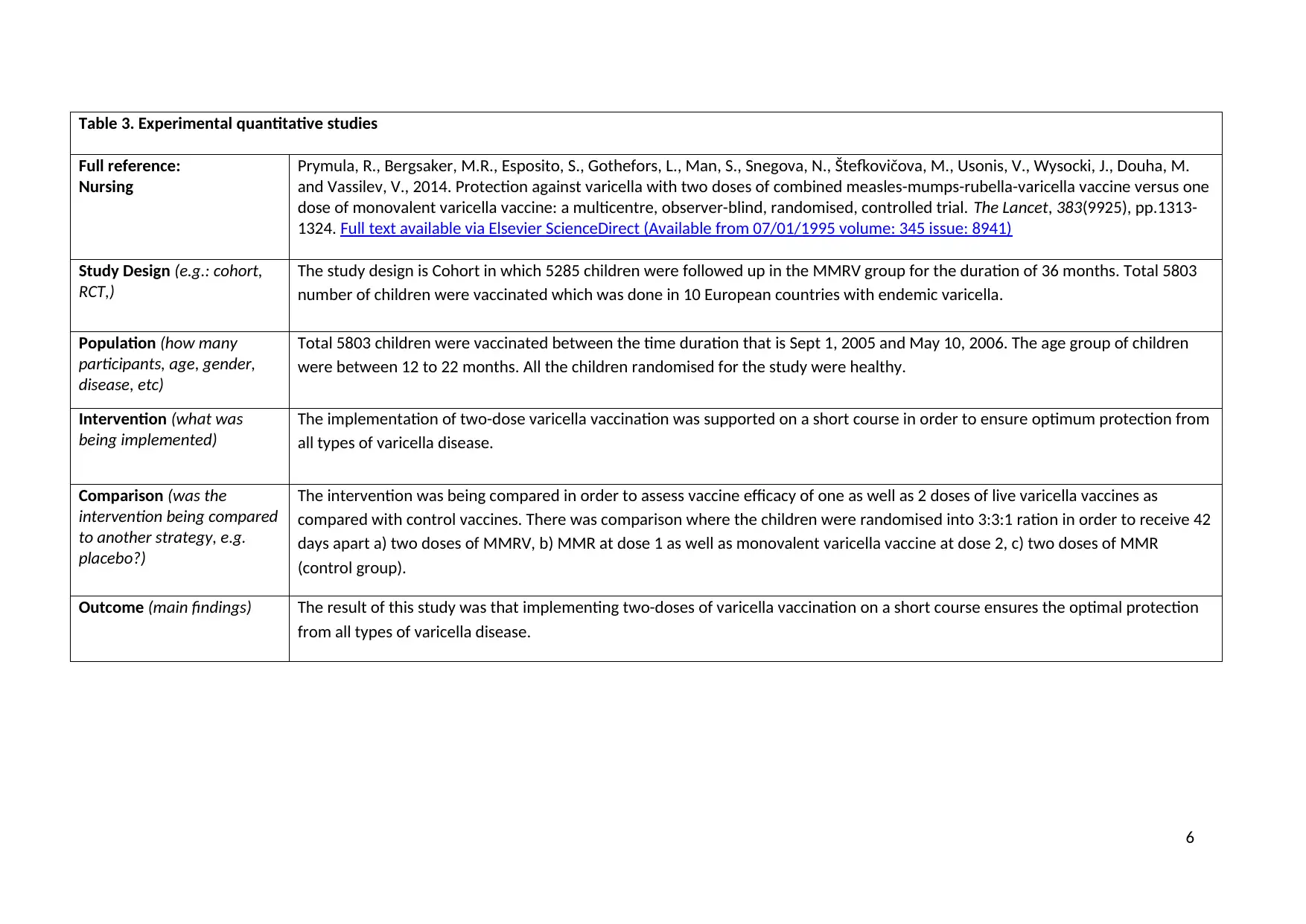
Table 3. Experimental quantitative studies
Full reference:
Nursing
Prymula, R., Bergsaker, M.R., Esposito, S., Gothefors, L., Man, S., Snegova, N., Štefkovičova, M., Usonis, V., Wysocki, J., Douha, M.
and Vassilev, V., 2014. Protection against varicella with two doses of combined measles-mumps-rubella-varicella vaccine versus one
dose of monovalent varicella vaccine: a multicentre, observer-blind, randomised, controlled trial. The Lancet, 383(9925), pp.1313-
1324. Full text available via Elsevier ScienceDirect (Available from 07/01/1995 volume: 345 issue: 8941)
Study Design (e.g.: cohort,
RCT,)
The study design is Cohort in which 5285 children were followed up in the MMRV group for the duration of 36 months. Total 5803
number of children were vaccinated which was done in 10 European countries with endemic varicella.
Population (how many
participants, age, gender,
disease, etc)
Total 5803 children were vaccinated between the time duration that is Sept 1, 2005 and May 10, 2006. The age group of children
were between 12 to 22 months. All the children randomised for the study were healthy.
Intervention (what was
being implemented)
The implementation of two-dose varicella vaccination was supported on a short course in order to ensure optimum protection from
all types of varicella disease.
Comparison (was the
intervention being compared
to another strategy, e.g.
placebo?)
The intervention was being compared in order to assess vaccine efficacy of one as well as 2 doses of live varicella vaccines as
compared with control vaccines. There was comparison where the children were randomised into 3:3:1 ration in order to receive 42
days apart a) two doses of MMRV, b) MMR at dose 1 as well as monovalent varicella vaccine at dose 2, c) two doses of MMR
(control group).
Outcome (main findings) The result of this study was that implementing two-doses of varicella vaccination on a short course ensures the optimal protection
from all types of varicella disease.
6
Full reference:
Nursing
Prymula, R., Bergsaker, M.R., Esposito, S., Gothefors, L., Man, S., Snegova, N., Štefkovičova, M., Usonis, V., Wysocki, J., Douha, M.
and Vassilev, V., 2014. Protection against varicella with two doses of combined measles-mumps-rubella-varicella vaccine versus one
dose of monovalent varicella vaccine: a multicentre, observer-blind, randomised, controlled trial. The Lancet, 383(9925), pp.1313-
1324. Full text available via Elsevier ScienceDirect (Available from 07/01/1995 volume: 345 issue: 8941)
Study Design (e.g.: cohort,
RCT,)
The study design is Cohort in which 5285 children were followed up in the MMRV group for the duration of 36 months. Total 5803
number of children were vaccinated which was done in 10 European countries with endemic varicella.
Population (how many
participants, age, gender,
disease, etc)
Total 5803 children were vaccinated between the time duration that is Sept 1, 2005 and May 10, 2006. The age group of children
were between 12 to 22 months. All the children randomised for the study were healthy.
Intervention (what was
being implemented)
The implementation of two-dose varicella vaccination was supported on a short course in order to ensure optimum protection from
all types of varicella disease.
Comparison (was the
intervention being compared
to another strategy, e.g.
placebo?)
The intervention was being compared in order to assess vaccine efficacy of one as well as 2 doses of live varicella vaccines as
compared with control vaccines. There was comparison where the children were randomised into 3:3:1 ration in order to receive 42
days apart a) two doses of MMRV, b) MMR at dose 1 as well as monovalent varicella vaccine at dose 2, c) two doses of MMR
(control group).
Outcome (main findings) The result of this study was that implementing two-doses of varicella vaccination on a short course ensures the optimal protection
from all types of varicella disease.
6
Paraphrase This Document
Need a fresh take? Get an instant paraphrase of this document with our AI Paraphraser
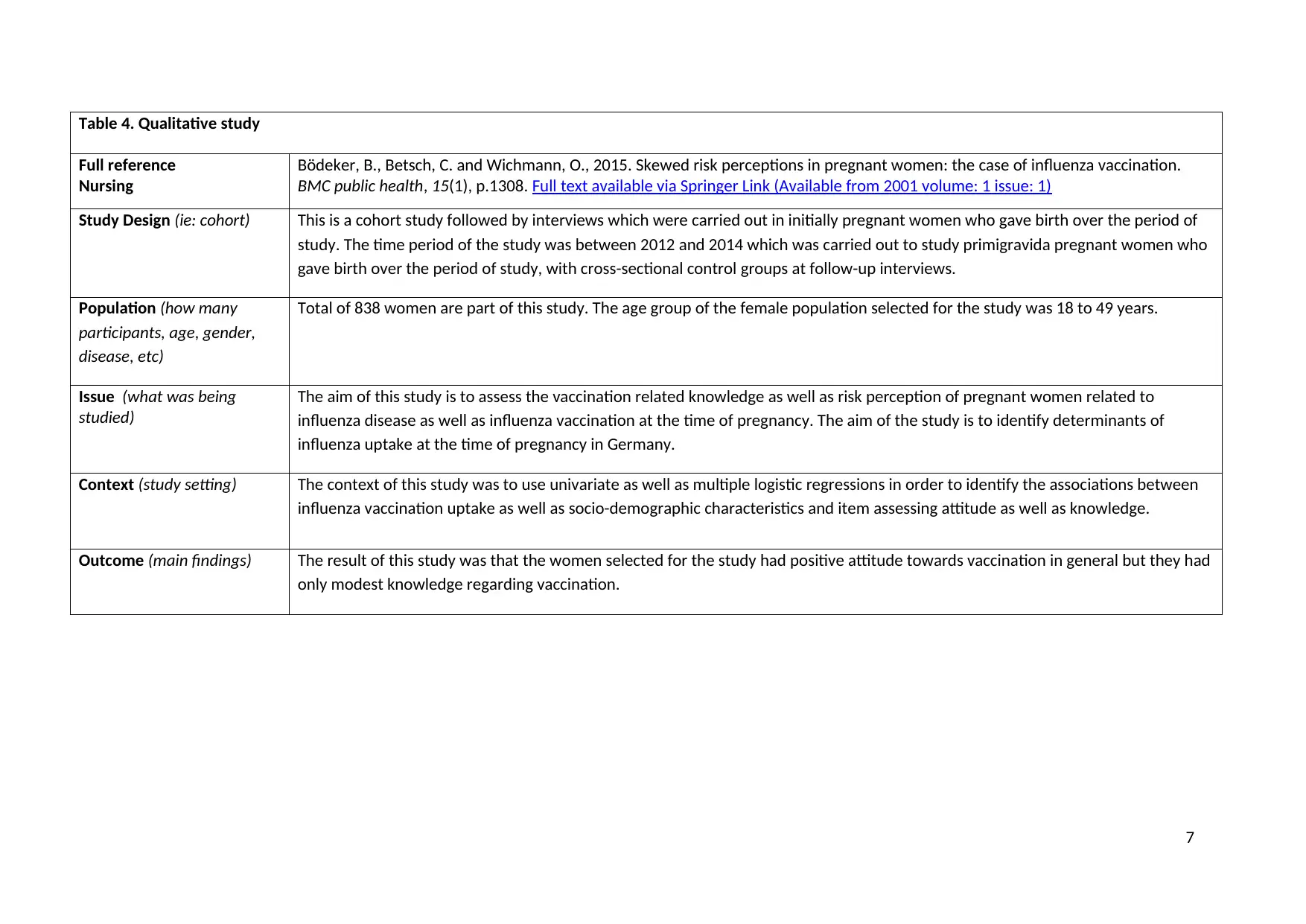
Table 4. Qualitative study
Full reference
Nursing
Bödeker, B., Betsch, C. and Wichmann, O., 2015. Skewed risk perceptions in pregnant women: the case of influenza vaccination.
BMC public health, 15(1), p.1308. Full text available via Springer Link (Available from 2001 volume: 1 issue: 1)
Study Design (ie: cohort) This is a cohort study followed by interviews which were carried out in initially pregnant women who gave birth over the period of
study. The time period of the study was between 2012 and 2014 which was carried out to study primigravida pregnant women who
gave birth over the period of study, with cross-sectional control groups at follow-up interviews.
Population (how many
participants, age, gender,
disease, etc)
Total of 838 women are part of this study. The age group of the female population selected for the study was 18 to 49 years.
Issue (what was being
studied)
The aim of this study is to assess the vaccination related knowledge as well as risk perception of pregnant women related to
influenza disease as well as influenza vaccination at the time of pregnancy. The aim of the study is to identify determinants of
influenza uptake at the time of pregnancy in Germany.
Context (study setting) The context of this study was to use univariate as well as multiple logistic regressions in order to identify the associations between
influenza vaccination uptake as well as socio-demographic characteristics and item assessing attitude as well as knowledge.
Outcome (main findings) The result of this study was that the women selected for the study had positive attitude towards vaccination in general but they had
only modest knowledge regarding vaccination.
7
Full reference
Nursing
Bödeker, B., Betsch, C. and Wichmann, O., 2015. Skewed risk perceptions in pregnant women: the case of influenza vaccination.
BMC public health, 15(1), p.1308. Full text available via Springer Link (Available from 2001 volume: 1 issue: 1)
Study Design (ie: cohort) This is a cohort study followed by interviews which were carried out in initially pregnant women who gave birth over the period of
study. The time period of the study was between 2012 and 2014 which was carried out to study primigravida pregnant women who
gave birth over the period of study, with cross-sectional control groups at follow-up interviews.
Population (how many
participants, age, gender,
disease, etc)
Total of 838 women are part of this study. The age group of the female population selected for the study was 18 to 49 years.
Issue (what was being
studied)
The aim of this study is to assess the vaccination related knowledge as well as risk perception of pregnant women related to
influenza disease as well as influenza vaccination at the time of pregnancy. The aim of the study is to identify determinants of
influenza uptake at the time of pregnancy in Germany.
Context (study setting) The context of this study was to use univariate as well as multiple logistic regressions in order to identify the associations between
influenza vaccination uptake as well as socio-demographic characteristics and item assessing attitude as well as knowledge.
Outcome (main findings) The result of this study was that the women selected for the study had positive attitude towards vaccination in general but they had
only modest knowledge regarding vaccination.
7
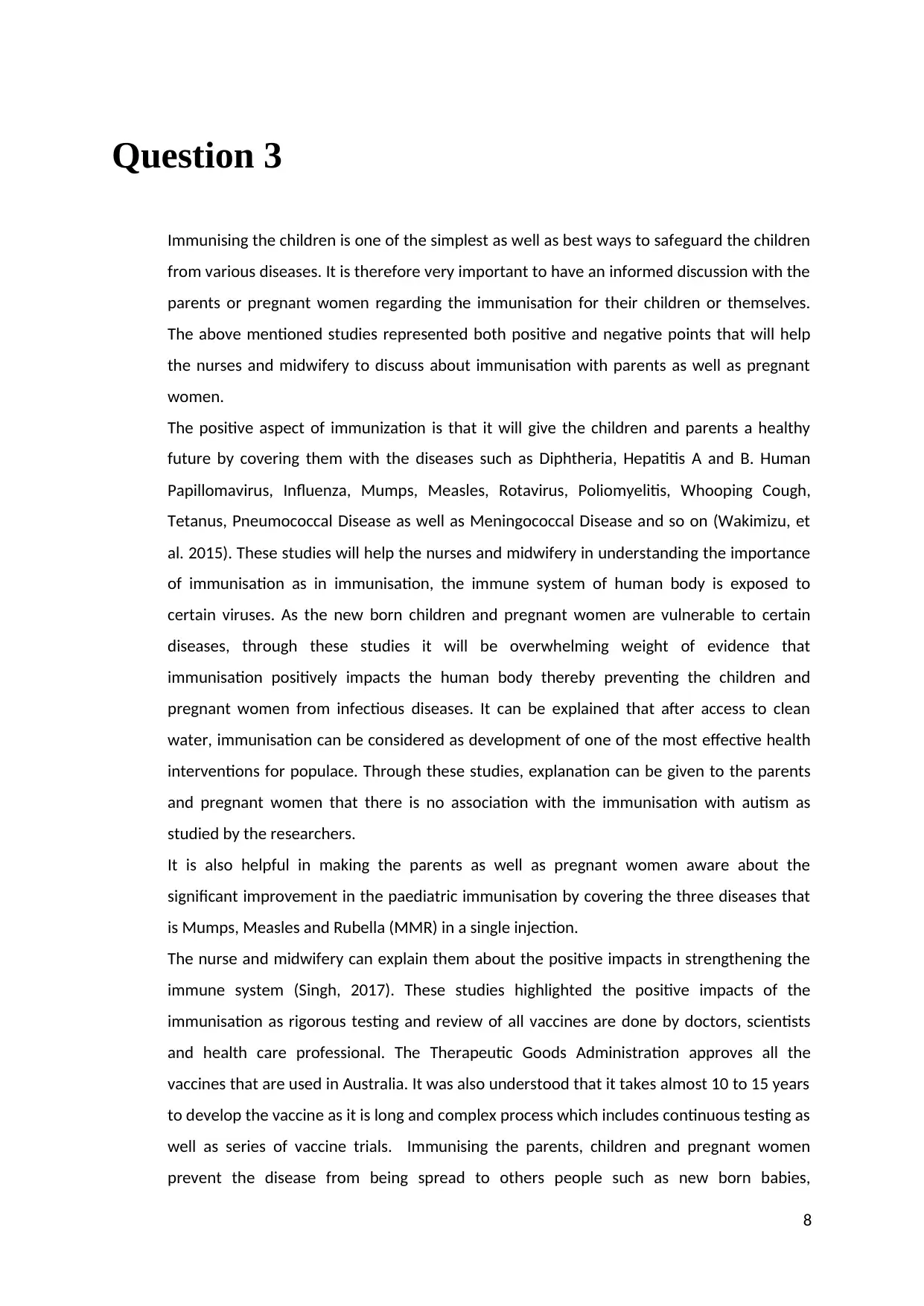
Question 3
Immunising the children is one of the simplest as well as best ways to safeguard the children
from various diseases. It is therefore very important to have an informed discussion with the
parents or pregnant women regarding the immunisation for their children or themselves.
The above mentioned studies represented both positive and negative points that will help
the nurses and midwifery to discuss about immunisation with parents as well as pregnant
women.
The positive aspect of immunization is that it will give the children and parents a healthy
future by covering them with the diseases such as Diphtheria, Hepatitis A and B. Human
Papillomavirus, Influenza, Mumps, Measles, Rotavirus, Poliomyelitis, Whooping Cough,
Tetanus, Pneumococcal Disease as well as Meningococcal Disease and so on (Wakimizu, et
al. 2015). These studies will help the nurses and midwifery in understanding the importance
of immunisation as in immunisation, the immune system of human body is exposed to
certain viruses. As the new born children and pregnant women are vulnerable to certain
diseases, through these studies it will be overwhelming weight of evidence that
immunisation positively impacts the human body thereby preventing the children and
pregnant women from infectious diseases. It can be explained that after access to clean
water, immunisation can be considered as development of one of the most effective health
interventions for populace. Through these studies, explanation can be given to the parents
and pregnant women that there is no association with the immunisation with autism as
studied by the researchers.
It is also helpful in making the parents as well as pregnant women aware about the
significant improvement in the paediatric immunisation by covering the three diseases that
is Mumps, Measles and Rubella (MMR) in a single injection.
The nurse and midwifery can explain them about the positive impacts in strengthening the
immune system (Singh, 2017). These studies highlighted the positive impacts of the
immunisation as rigorous testing and review of all vaccines are done by doctors, scientists
and health care professional. The Therapeutic Goods Administration approves all the
vaccines that are used in Australia. It was also understood that it takes almost 10 to 15 years
to develop the vaccine as it is long and complex process which includes continuous testing as
well as series of vaccine trials. Immunising the parents, children and pregnant women
prevent the disease from being spread to others people such as new born babies,
8
Immunising the children is one of the simplest as well as best ways to safeguard the children
from various diseases. It is therefore very important to have an informed discussion with the
parents or pregnant women regarding the immunisation for their children or themselves.
The above mentioned studies represented both positive and negative points that will help
the nurses and midwifery to discuss about immunisation with parents as well as pregnant
women.
The positive aspect of immunization is that it will give the children and parents a healthy
future by covering them with the diseases such as Diphtheria, Hepatitis A and B. Human
Papillomavirus, Influenza, Mumps, Measles, Rotavirus, Poliomyelitis, Whooping Cough,
Tetanus, Pneumococcal Disease as well as Meningococcal Disease and so on (Wakimizu, et
al. 2015). These studies will help the nurses and midwifery in understanding the importance
of immunisation as in immunisation, the immune system of human body is exposed to
certain viruses. As the new born children and pregnant women are vulnerable to certain
diseases, through these studies it will be overwhelming weight of evidence that
immunisation positively impacts the human body thereby preventing the children and
pregnant women from infectious diseases. It can be explained that after access to clean
water, immunisation can be considered as development of one of the most effective health
interventions for populace. Through these studies, explanation can be given to the parents
and pregnant women that there is no association with the immunisation with autism as
studied by the researchers.
It is also helpful in making the parents as well as pregnant women aware about the
significant improvement in the paediatric immunisation by covering the three diseases that
is Mumps, Measles and Rubella (MMR) in a single injection.
The nurse and midwifery can explain them about the positive impacts in strengthening the
immune system (Singh, 2017). These studies highlighted the positive impacts of the
immunisation as rigorous testing and review of all vaccines are done by doctors, scientists
and health care professional. The Therapeutic Goods Administration approves all the
vaccines that are used in Australia. It was also understood that it takes almost 10 to 15 years
to develop the vaccine as it is long and complex process which includes continuous testing as
well as series of vaccine trials. Immunising the parents, children and pregnant women
prevent the disease from being spread to others people such as new born babies,
8
⊘ This is a preview!⊘
Do you want full access?
Subscribe today to unlock all pages.

Trusted by 1+ million students worldwide
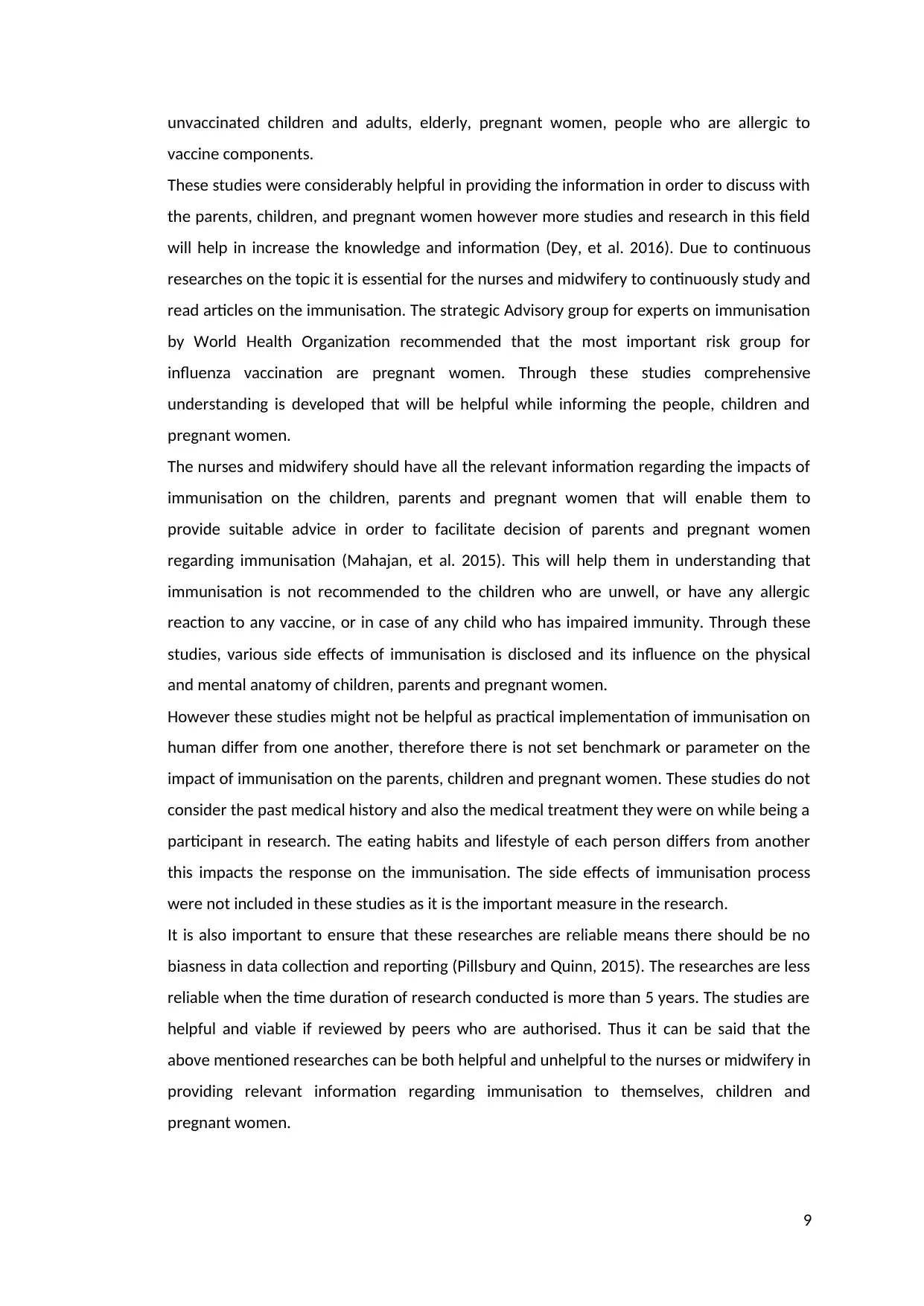
unvaccinated children and adults, elderly, pregnant women, people who are allergic to
vaccine components.
These studies were considerably helpful in providing the information in order to discuss with
the parents, children, and pregnant women however more studies and research in this field
will help in increase the knowledge and information (Dey, et al. 2016). Due to continuous
researches on the topic it is essential for the nurses and midwifery to continuously study and
read articles on the immunisation. The strategic Advisory group for experts on immunisation
by World Health Organization recommended that the most important risk group for
influenza vaccination are pregnant women. Through these studies comprehensive
understanding is developed that will be helpful while informing the people, children and
pregnant women.
The nurses and midwifery should have all the relevant information regarding the impacts of
immunisation on the children, parents and pregnant women that will enable them to
provide suitable advice in order to facilitate decision of parents and pregnant women
regarding immunisation (Mahajan, et al. 2015). This will help them in understanding that
immunisation is not recommended to the children who are unwell, or have any allergic
reaction to any vaccine, or in case of any child who has impaired immunity. Through these
studies, various side effects of immunisation is disclosed and its influence on the physical
and mental anatomy of children, parents and pregnant women.
However these studies might not be helpful as practical implementation of immunisation on
human differ from one another, therefore there is not set benchmark or parameter on the
impact of immunisation on the parents, children and pregnant women. These studies do not
consider the past medical history and also the medical treatment they were on while being a
participant in research. The eating habits and lifestyle of each person differs from another
this impacts the response on the immunisation. The side effects of immunisation process
were not included in these studies as it is the important measure in the research.
It is also important to ensure that these researches are reliable means there should be no
biasness in data collection and reporting (Pillsbury and Quinn, 2015). The researches are less
reliable when the time duration of research conducted is more than 5 years. The studies are
helpful and viable if reviewed by peers who are authorised. Thus it can be said that the
above mentioned researches can be both helpful and unhelpful to the nurses or midwifery in
providing relevant information regarding immunisation to themselves, children and
pregnant women.
9
vaccine components.
These studies were considerably helpful in providing the information in order to discuss with
the parents, children, and pregnant women however more studies and research in this field
will help in increase the knowledge and information (Dey, et al. 2016). Due to continuous
researches on the topic it is essential for the nurses and midwifery to continuously study and
read articles on the immunisation. The strategic Advisory group for experts on immunisation
by World Health Organization recommended that the most important risk group for
influenza vaccination are pregnant women. Through these studies comprehensive
understanding is developed that will be helpful while informing the people, children and
pregnant women.
The nurses and midwifery should have all the relevant information regarding the impacts of
immunisation on the children, parents and pregnant women that will enable them to
provide suitable advice in order to facilitate decision of parents and pregnant women
regarding immunisation (Mahajan, et al. 2015). This will help them in understanding that
immunisation is not recommended to the children who are unwell, or have any allergic
reaction to any vaccine, or in case of any child who has impaired immunity. Through these
studies, various side effects of immunisation is disclosed and its influence on the physical
and mental anatomy of children, parents and pregnant women.
However these studies might not be helpful as practical implementation of immunisation on
human differ from one another, therefore there is not set benchmark or parameter on the
impact of immunisation on the parents, children and pregnant women. These studies do not
consider the past medical history and also the medical treatment they were on while being a
participant in research. The eating habits and lifestyle of each person differs from another
this impacts the response on the immunisation. The side effects of immunisation process
were not included in these studies as it is the important measure in the research.
It is also important to ensure that these researches are reliable means there should be no
biasness in data collection and reporting (Pillsbury and Quinn, 2015). The researches are less
reliable when the time duration of research conducted is more than 5 years. The studies are
helpful and viable if reviewed by peers who are authorised. Thus it can be said that the
above mentioned researches can be both helpful and unhelpful to the nurses or midwifery in
providing relevant information regarding immunisation to themselves, children and
pregnant women.
9
Paraphrase This Document
Need a fresh take? Get an instant paraphrase of this document with our AI Paraphraser
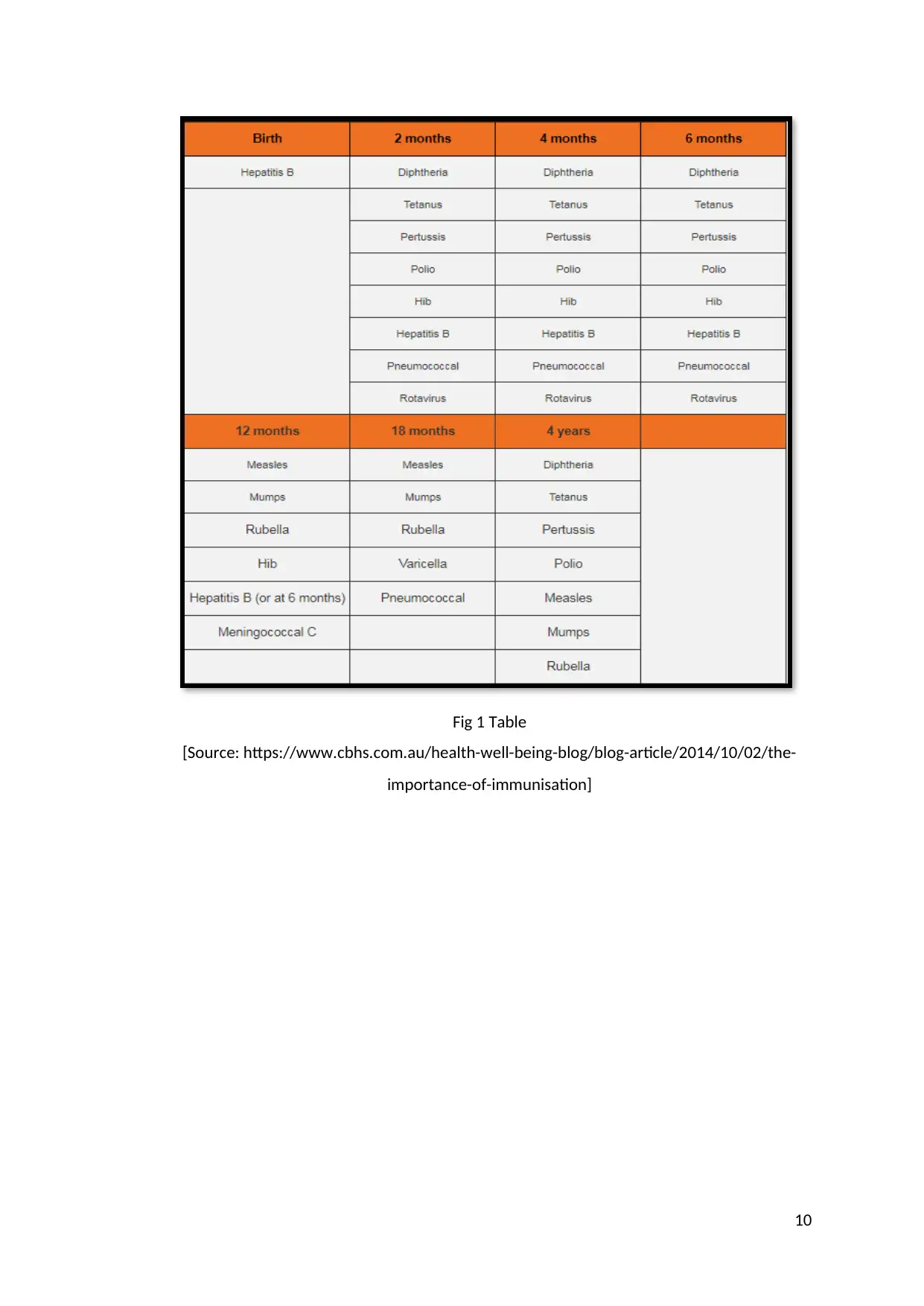
Fig 1 Table
[Source: https://www.cbhs.com.au/health-well-being-blog/blog-article/2014/10/02/the-
importance-of-immunisation]
10
[Source: https://www.cbhs.com.au/health-well-being-blog/blog-article/2014/10/02/the-
importance-of-immunisation]
10
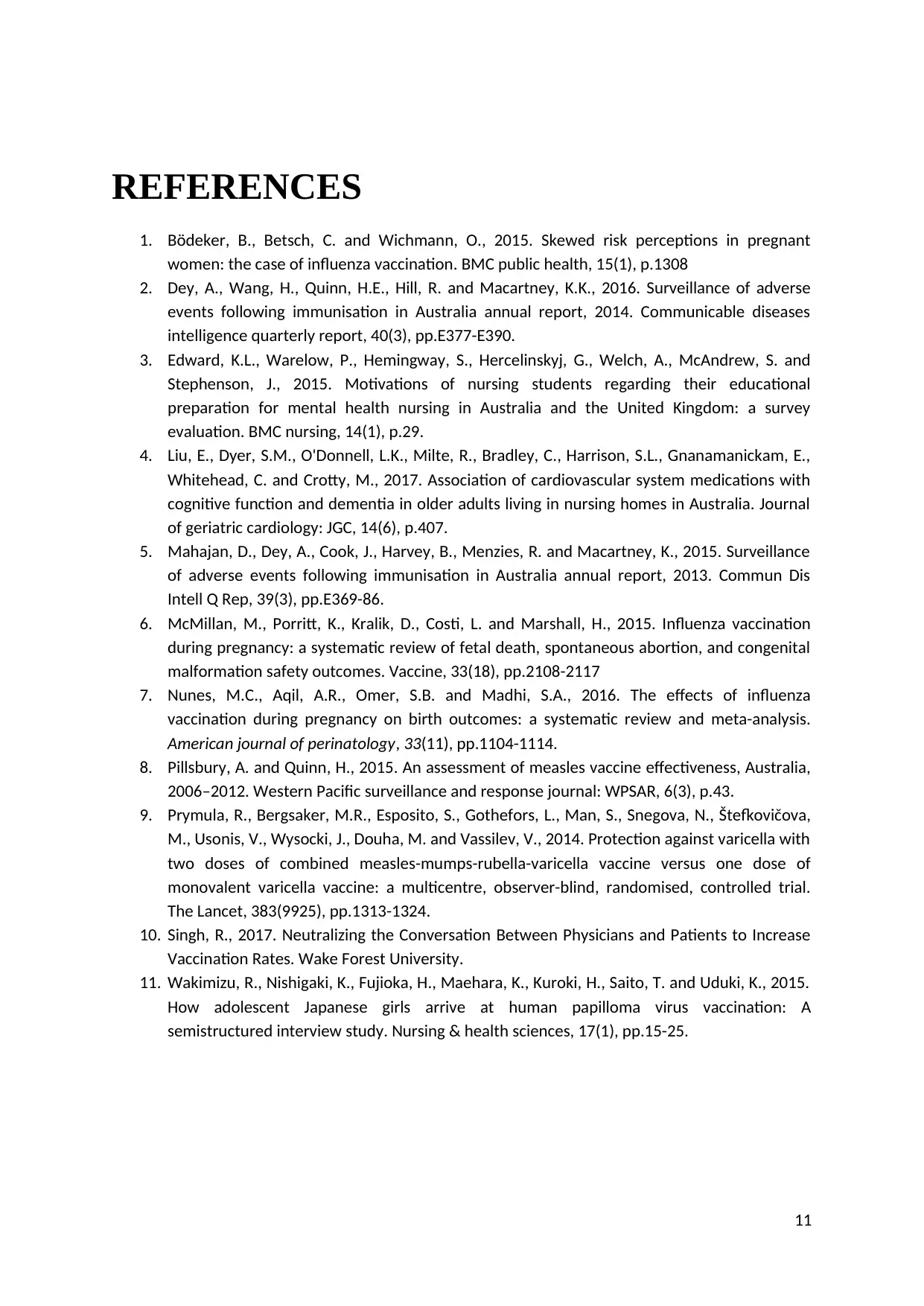
REFERENCES
1. Bödeker, B., Betsch, C. and Wichmann, O., 2015. Skewed risk perceptions in pregnant
women: the case of influenza vaccination. BMC public health, 15(1), p.1308
2. Dey, A., Wang, H., Quinn, H.E., Hill, R. and Macartney, K.K., 2016. Surveillance of adverse
events following immunisation in Australia annual report, 2014. Communicable diseases
intelligence quarterly report, 40(3), pp.E377-E390.
3. Edward, K.L., Warelow, P., Hemingway, S., Hercelinskyj, G., Welch, A., McAndrew, S. and
Stephenson, J., 2015. Motivations of nursing students regarding their educational
preparation for mental health nursing in Australia and the United Kingdom: a survey
evaluation. BMC nursing, 14(1), p.29.
4. Liu, E., Dyer, S.M., O'Donnell, L.K., Milte, R., Bradley, C., Harrison, S.L., Gnanamanickam, E.,
Whitehead, C. and Crotty, M., 2017. Association of cardiovascular system medications with
cognitive function and dementia in older adults living in nursing homes in Australia. Journal
of geriatric cardiology: JGC, 14(6), p.407.
5. Mahajan, D., Dey, A., Cook, J., Harvey, B., Menzies, R. and Macartney, K., 2015. Surveillance
of adverse events following immunisation in Australia annual report, 2013. Commun Dis
Intell Q Rep, 39(3), pp.E369-86.
6. McMillan, M., Porritt, K., Kralik, D., Costi, L. and Marshall, H., 2015. Influenza vaccination
during pregnancy: a systematic review of fetal death, spontaneous abortion, and congenital
malformation safety outcomes. Vaccine, 33(18), pp.2108-2117
7. Nunes, M.C., Aqil, A.R., Omer, S.B. and Madhi, S.A., 2016. The effects of influenza
vaccination during pregnancy on birth outcomes: a systematic review and meta-analysis.
American journal of perinatology, 33(11), pp.1104-1114.
8. Pillsbury, A. and Quinn, H., 2015. An assessment of measles vaccine effectiveness, Australia,
2006–2012. Western Pacific surveillance and response journal: WPSAR, 6(3), p.43.
9. Prymula, R., Bergsaker, M.R., Esposito, S., Gothefors, L., Man, S., Snegova, N., Štefkovičova,
M., Usonis, V., Wysocki, J., Douha, M. and Vassilev, V., 2014. Protection against varicella with
two doses of combined measles-mumps-rubella-varicella vaccine versus one dose of
monovalent varicella vaccine: a multicentre, observer-blind, randomised, controlled trial.
The Lancet, 383(9925), pp.1313-1324.
10. Singh, R., 2017. Neutralizing the Conversation Between Physicians and Patients to Increase
Vaccination Rates. Wake Forest University.
11. Wakimizu, R., Nishigaki, K., Fujioka, H., Maehara, K., Kuroki, H., Saito, T. and Uduki, K., 2015.
How adolescent Japanese girls arrive at human papilloma virus vaccination: A
semistructured interview study. Nursing & health sciences, 17(1), pp.15-25.
11
1. Bödeker, B., Betsch, C. and Wichmann, O., 2015. Skewed risk perceptions in pregnant
women: the case of influenza vaccination. BMC public health, 15(1), p.1308
2. Dey, A., Wang, H., Quinn, H.E., Hill, R. and Macartney, K.K., 2016. Surveillance of adverse
events following immunisation in Australia annual report, 2014. Communicable diseases
intelligence quarterly report, 40(3), pp.E377-E390.
3. Edward, K.L., Warelow, P., Hemingway, S., Hercelinskyj, G., Welch, A., McAndrew, S. and
Stephenson, J., 2015. Motivations of nursing students regarding their educational
preparation for mental health nursing in Australia and the United Kingdom: a survey
evaluation. BMC nursing, 14(1), p.29.
4. Liu, E., Dyer, S.M., O'Donnell, L.K., Milte, R., Bradley, C., Harrison, S.L., Gnanamanickam, E.,
Whitehead, C. and Crotty, M., 2017. Association of cardiovascular system medications with
cognitive function and dementia in older adults living in nursing homes in Australia. Journal
of geriatric cardiology: JGC, 14(6), p.407.
5. Mahajan, D., Dey, A., Cook, J., Harvey, B., Menzies, R. and Macartney, K., 2015. Surveillance
of adverse events following immunisation in Australia annual report, 2013. Commun Dis
Intell Q Rep, 39(3), pp.E369-86.
6. McMillan, M., Porritt, K., Kralik, D., Costi, L. and Marshall, H., 2015. Influenza vaccination
during pregnancy: a systematic review of fetal death, spontaneous abortion, and congenital
malformation safety outcomes. Vaccine, 33(18), pp.2108-2117
7. Nunes, M.C., Aqil, A.R., Omer, S.B. and Madhi, S.A., 2016. The effects of influenza
vaccination during pregnancy on birth outcomes: a systematic review and meta-analysis.
American journal of perinatology, 33(11), pp.1104-1114.
8. Pillsbury, A. and Quinn, H., 2015. An assessment of measles vaccine effectiveness, Australia,
2006–2012. Western Pacific surveillance and response journal: WPSAR, 6(3), p.43.
9. Prymula, R., Bergsaker, M.R., Esposito, S., Gothefors, L., Man, S., Snegova, N., Štefkovičova,
M., Usonis, V., Wysocki, J., Douha, M. and Vassilev, V., 2014. Protection against varicella with
two doses of combined measles-mumps-rubella-varicella vaccine versus one dose of
monovalent varicella vaccine: a multicentre, observer-blind, randomised, controlled trial.
The Lancet, 383(9925), pp.1313-1324.
10. Singh, R., 2017. Neutralizing the Conversation Between Physicians and Patients to Increase
Vaccination Rates. Wake Forest University.
11. Wakimizu, R., Nishigaki, K., Fujioka, H., Maehara, K., Kuroki, H., Saito, T. and Uduki, K., 2015.
How adolescent Japanese girls arrive at human papilloma virus vaccination: A
semistructured interview study. Nursing & health sciences, 17(1), pp.15-25.
11
⊘ This is a preview!⊘
Do you want full access?
Subscribe today to unlock all pages.

Trusted by 1+ million students worldwide
1 out of 12
Related Documents
Your All-in-One AI-Powered Toolkit for Academic Success.
+13062052269
info@desklib.com
Available 24*7 on WhatsApp / Email
![[object Object]](/_next/static/media/star-bottom.7253800d.svg)
Unlock your academic potential
Copyright © 2020–2026 A2Z Services. All Rights Reserved. Developed and managed by ZUCOL.





